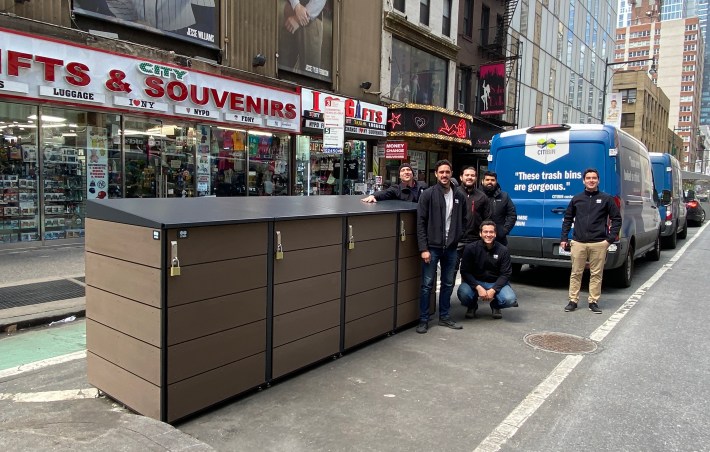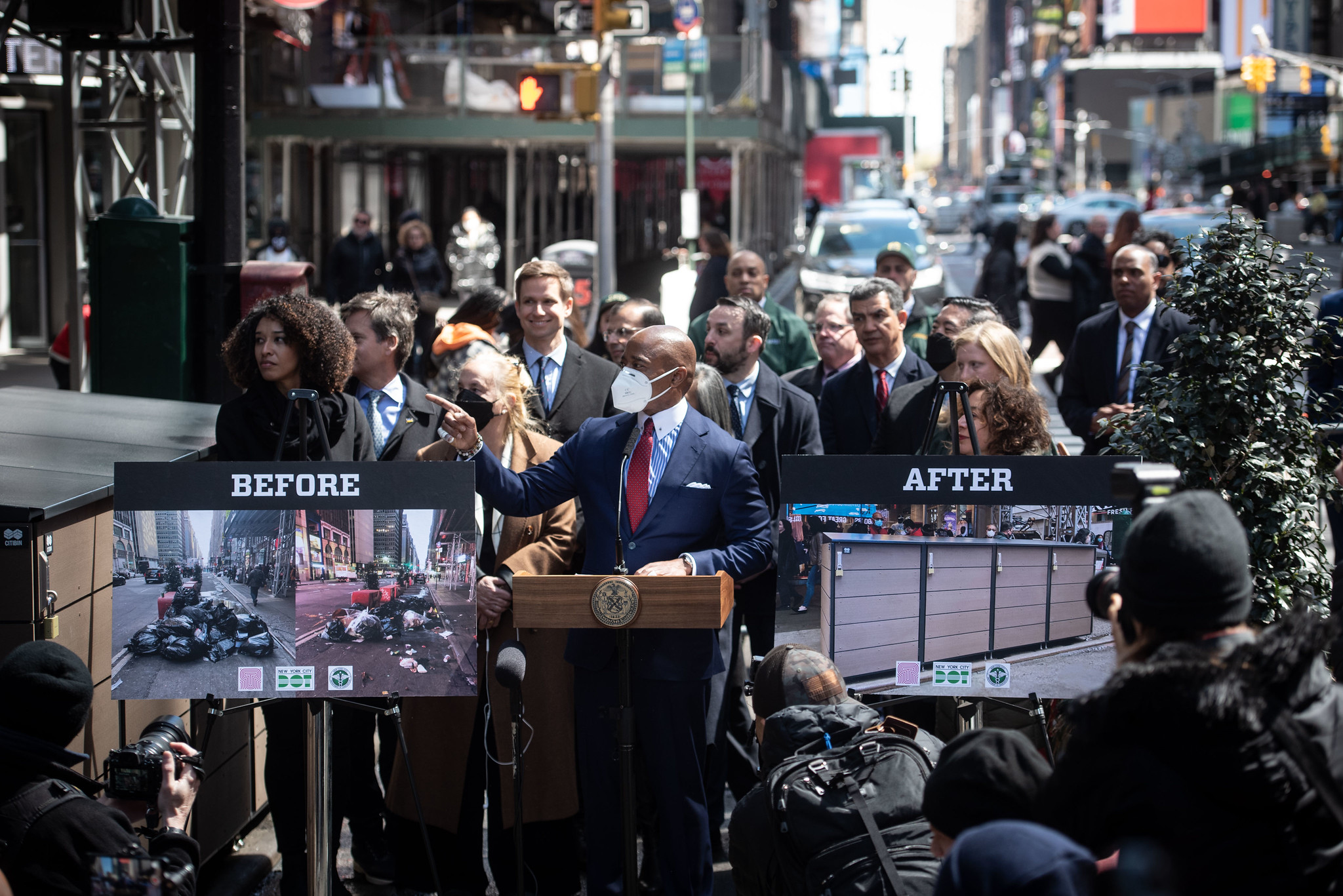It's in the bag! Well, kinda.
The city will extend its limited "Clean Curbs" pilot program — aimed at beating back the mountain of leaky trash bags on city sidewalks — to all boroughs, Mayor Adams announced on Wednesday at a Manhattan press conference unveiling part of the program's first installation: a single four-bin trash enclosure at the corner of Seventh Avenue and W. 41st Street.
Brooklyn is the next borough that will likely see Clean Curbs action, Streetsblog has learned.
Pointing to the newly installed enclosure, which was paid for by the Times Square Alliance, the area's business improvement district, Adams said that New Yorkers could look forward to the day when "all five boroughs will have a semblance of these containers," quoting the (not-too-impressive) figure of $1.3 million as the sum for the program "across the city." (The sum amounts to not even a rounding error in a city budget of $98 billion.)
He also did not supply any timeline for that aim — and at an unrelated press conference later in he day, declined to answer a Streetsblog reporter's question asking for more specifics as to when city streets might look any different. He did, however, unleash some soaring rhetoric.
"We're not here simply to talk trash ... [but] to ensure that the streetscape is as beautiful as the people who walk in the streets," Adams said at Times Square, adding, "Our top priority is to create a clean and safe city," he said, adding (in a typical Adamsian flourish) that "Cleanliness is next to godliness!"
Nor did the city bring reporters to the second trash enclosure that the Times Square BID installed, which sits in the street in a former "parking space" alongside the bike lane at W. 43rd Street and Eighth Avenue. The city long has been hostile to using the curbside lane of roadways for anything but storage of cars — so the Eighth Avenue bin is located in a much more controversial venue.

The announcement comes as New Yorkers are increasingly noticing the city’s 5 o'clock shadow — the fact that, every afternoon, the sidewalks fill with big plastic garbage bags, restricting public space, undermining pedestrians' egress and attracting rats. Their representative have heard them: City Council members long have urged the Sanitation and Transportation departments to work together to get trash out of pedestrians' way.
“New Yorkers deserve to live in communities that are safe and clean," Speaker Adrienne Adams said in a statement. "I applaud Mayor Adams and the Department of Sanitation for moving forward with this pilot program for containerization, which the Council prioritized in its Preliminary Budget Response. This can be a critical part of the city’s waste management landscape, and we look forward to our continued partnership in achieving the necessary sanitation investments for New York City.”
And Transportation Alternatives is drawing attention to the problem with a "March Madness"-style competition pitting different mounds of trash against others piles of refuse.
We'll be back tomorrow with the championship round of #TrashMadness.
— Transportation Alternatives *Vote on Sammy's Law* (@TransAlt) April 19, 2022
Meanwhile, see a better use of our sidewalks than mountains of trash:https://t.co/ztB2XPlFEZ
The Adams administration has been groping for solutions to a multi-faceted trash problem: Beside the garbage on the sidewalks, there is too much garbage — a situation that is not being aided by the mayor's cuts to the expansion of the city's composting program. New Sanitation Commissioner Jessica Tisch promised reforms at a press conference on Monday, but could not provide a timeline for trash containerization. At the same press conference, Transportation Commissioner Ydanis Rodriguez said he needed City Hall to provide locations where his department could convert "parking" spaces to trash corrals.
Enter the business improvement districts, private entities that have arisen in the last 40 years to stopgap waning municipal services in commercial areas around the city. Even as critics lament the privatization of public space under the BIDs, the city needs the BIDs help with basic functions — and says as much.“The partnership between city agencies and our neighborhood business districts brings a new vision of how we prioritize sidewalk and curb space for safer, greener, cleaner public spaces throughout the city,” Deputy Mayor for Operations Meera Joshi said at the press conference.
Indeed, the next installments of Clean Curbs likely will involve two smaller BIDs, Montague Street BID in Downtown Brooklyn and Pitkin Avenue BID in Brownsville, which have been working with the Department of Sanitation for months on their own projects. It has been a slog.
"It's always difficult working with any city agency; it's giant machine," said Kate Chura, the executive director of the Montague Street BID. Chura praised the Sanitation Department staff as "responsive," but said that the program was "understaffed."
If it is hard for the city to make things happen, it may be because agency requirements are technical, but also political:
For each Clean Curbs container location, the city requires "at least three documents: (1) drawing, renderings or photo of the proposed container, (2) a site plan showing the location of the container for your preferred proposed location, and (3) a letter of support from the property owner(s) of the adjacent location(s)."
Multiple proposed locations require the submission of site plans and letters of support for each. The applicant must certify that the container is compatible with a host of specifications, including that it is "non-flammable construction, fully enclosed, and rodent-proof"; meets length, safety and siting requirements; commercial business recycling rules and regulations, and does "not cause undue burden for commercial carter collection operations."
Moreover — and this is a high hurdle for smaller, less-well-capitalized BIDs and community groups — they are "required to comply with the terms of the Maintenance Agreement for Public Space Waste Container" — meaning that they must keep the area clean of debris and snow and assume the cost of insurance and other liabilities.
Oh, and the entity must specify the parking regulations governing the space. All this must happen before the city can give its approval.
Even so, "New Yorkers have a right to know that a major change to their streetscape included a serious look at issues around access, siting, safety, maintenance – including in all four seasons, community usage, public health and rodents, and the realities of collection operations," Sanitation Department spokesman Joshua Goodman said in defending the program. "What good is a bin on the street if it’s designed in an unusable way, and ends up with trash dumped all around it anyway? We want to get this done, and we want to get it done right – so that it can be one piece of a solution to New York’s waste management universe, of which the biggest piece is public behavior and waste reduction."






